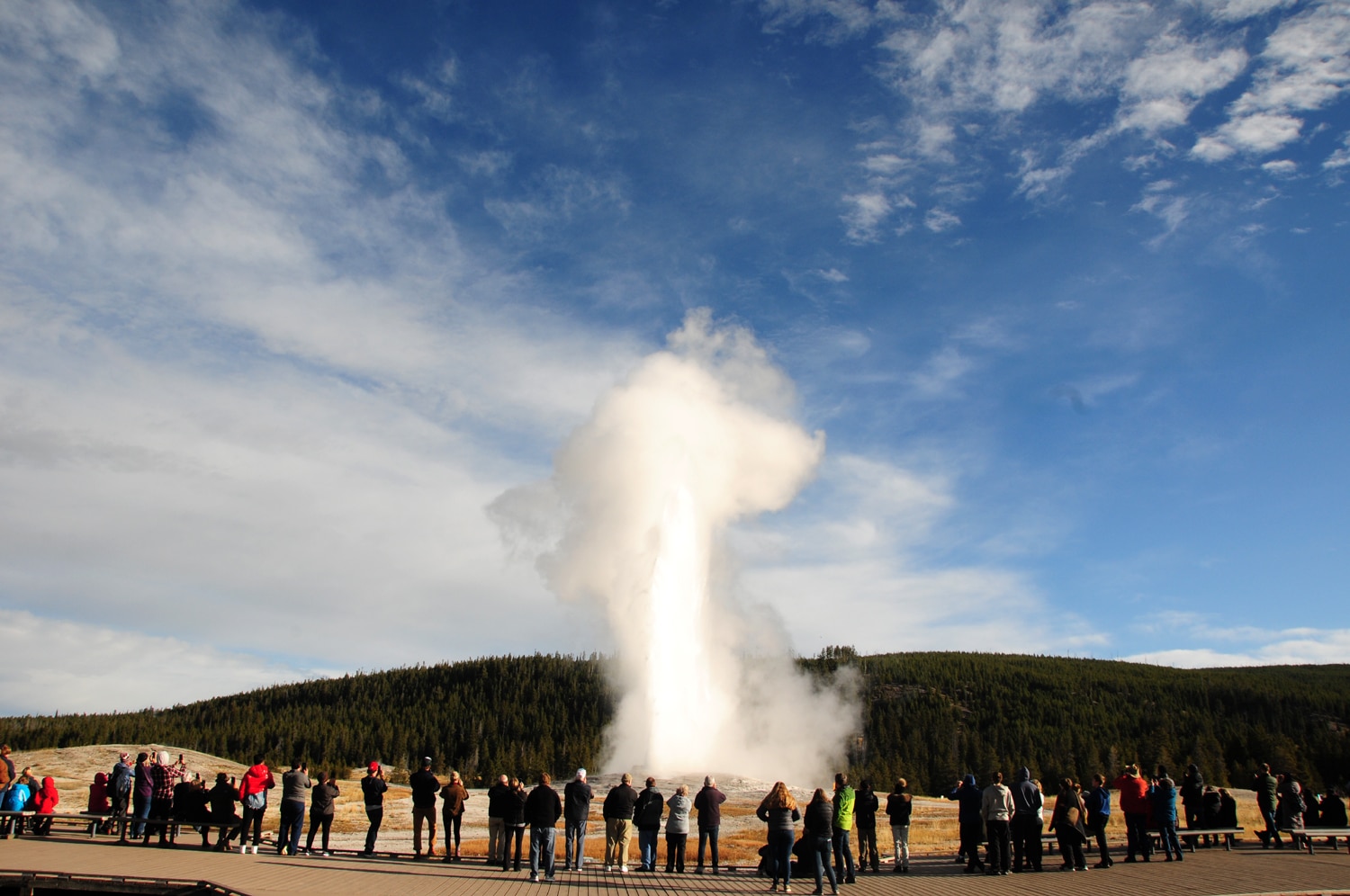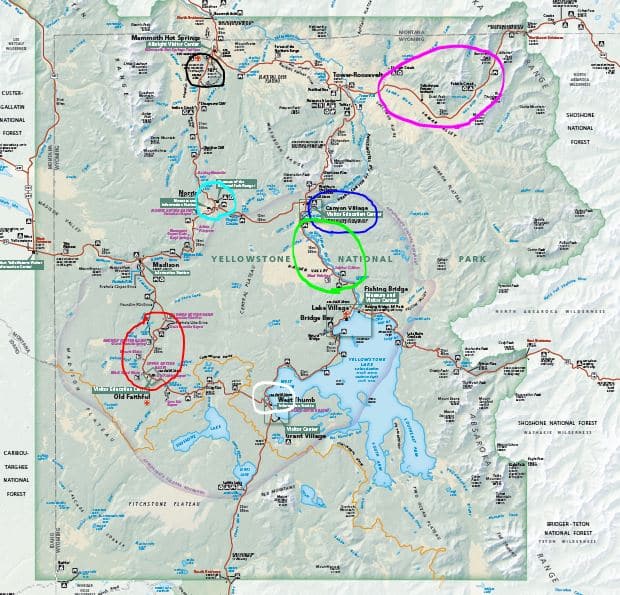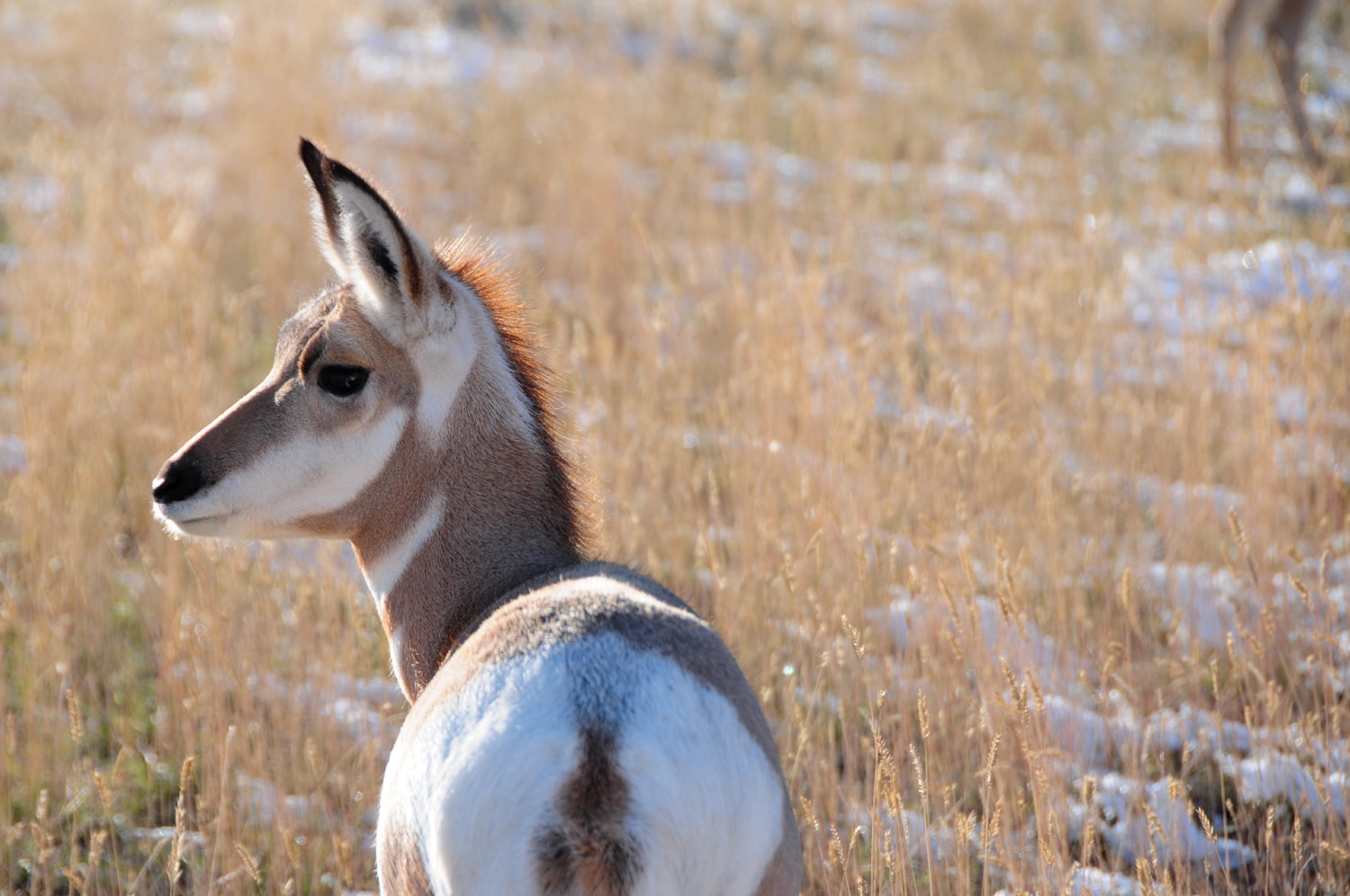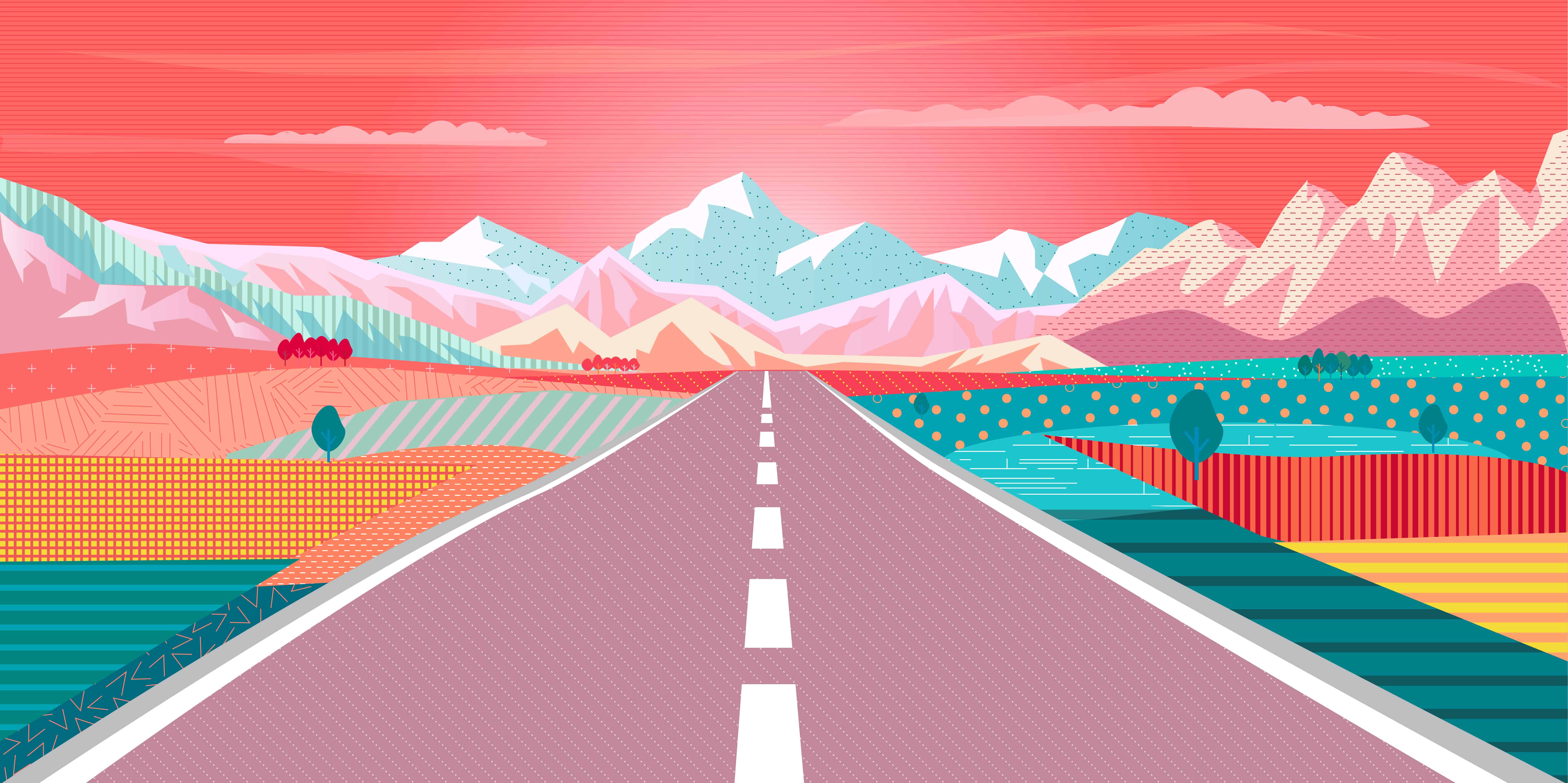Yellowstone National Park is perhaps the most famous national park in the world, and is indeed a place that has it all – wide rivers, deep canyons, snowy mountains, bears, wolves, herds of bison, and above all an abundance of erupting geysers, bubbling mud and a strong smell of sulfur in the air. According to different estimates, roughly half of all the geothermal geysers on Earth are located in Yellowstone. The region is known for being the place where magma from the Earth’s core is closer to the surface than any other place on the planet, creating a uniquely intense environment.
With an area equal to that of Puerto Rico, Yellowstone is one of the largest national parks in the US ( in the lower 48 it is second only to Death Valley National Park).The park lies in the wild heart of the Rocky Mountains, bordering Wyoming, Montana and Idaho. The vast majority of the park’s areas lie within the state of Wyoming, with small parts in Montana and Idaho. The story of Yellowstone begins about 640,000 years ago, when a huge volcanic eruption, possibly the largest the Earth has ever known, shook the Rocky Mountains, creating a vast crater 30 miles in diameter. Later eruptions continued to shape the region, filling the crater with molten magma that eventually cooled down into stone.
The extensive geothermal activity is not the only reason to visit Yellowstone, as the park is also a primordial land of grass prairies, deep canyons, pristine lakes and snowy peaks. The park is the heart of one of the largest intact ecosystems in the world, and is abundant with wildlife. Visiting the park’ you are sure to see herds of elk and bison, and with a little luck – moose, grizzly bears, black bears, wolves, coyotes and pronghorns.
Yellowstone is undoubtedly the hallmark of American national parks. In the park you can experience nature first hand, and witness unique sights, that are not found anywhere else on the planet. Consequently, the park was declared a World Heritage Site by UNESCO. The park has several distinct features, which makes visiting it a different experience compared to visiting other national parks. Firstly, the travel distances inside the park itself are long, so it is especially important to plan your visit carefully. Secondly, Yellowstone’s strength is best experienced not necessarily by hiking, but by driving the park’s scenic roads and visiting the geyser areas. As such, the park has much to offer even for those who are not adept hikers.
For recommended hotels in West Yellowstone click here, for recommended hotels in Gardiner click here.
When to visit Yellowstone National Park
The best time to visit the park is late spring to early autumn (early June to mid-September). Visiting in May and October is also possible but temperatures might be low and roads might be closed due to snow (especially in October). The park is mostly covered in snow during winter (November to April), and only the northern area of the park is open to vehicles. Winter sports enthusiasts can visit the park even in the winter months.
Below is a breakdown of weather in the park by season:
Spring (March-May): An un-crowded season in the park. Most park services are still closed in early spring, and the only road open to vehicle traffic is the road in the park’s north. This is a popular season for winter activities, such as cross country and snowshoeing. Temperatures are low even during the day, and the weather can be unpredictable. Roads throughout the park begin opening towards the end of April. In May, the bears wake up from their winter hibernation, and the region’s large mammals give birth (first the bison, then the elk, and finally the bears). You can spot mothers caring for their cubs. It is still too cold to camp throughout the park during spring, and most campgrounds are still closed.
Summer (June-August): Summer is a great season to visit Yellowstone National Park. Consequently, this is also the most crowded season in the park. However, due to the park’s large size, the crowds do not usually impair the trip, especially if you plan on hiking and visiting less toured areas. All the park’s roads are open during summer, and the weather is generally favorable for hiking. In June, the snow melts throughout most of the park, giving way to abloom of wildflowers. July and August are hot, and in some areas (mainly in the park’s north) the heat can even be quite oppressive during the afternoon (but towards evening it almost always cools down). During these months the bison mating season begins. The beasts will gather in large herds in Lamar and Hayden Valleys. Afternoon thunder storms are prominent during summer, and so are wildfires, which may cause temporary road closures. Nights are cold, even during summer, and temperatures can even drop below freezing, so even though this is an excellent season for scamping, be sure to bring warm sleeping bags.
Fall (September-November): Fall starts early in Yellowstone National Park. September brings with it a sharp drop in temperatures, and first snow can hit even during mid September, potentially causing road closures. Most of the park’s services (hotels, campgrounds, visitor centers, etc.) gradually close. Roads in the park gradually close, and by November all are closed except the one from Gardner to Cook City in the north. Fall, and especially September and October is the mating season of the Elk, and battles between bulls are an impressive sight. Camping is still possible in early September, but most campgrounds close as the season progresses.
Winter (December-February): A heavy blanket of snow covers the park during winter. All roads are closed with the exception of the road in the park’s north (from Gardner to Cook City), and winter tires and/or snow chains are also necessary for driving there, as well as a 4×4 vehicle. Those interested in winter sports can do so in the Mammoth area or the Old Faithful area (which can be reached by snowmobile or by bus). Heavy snowfall is prominent during winter, an day-time temperatures are well below freezing. Campgrounds are closed during winter (except for the Mammoth Campground).
Directions to the Park:
Yellowstone National Park has five entrances:
1. The North Entrance, nest to the small town of Gardiner and closest to the Mammoth hot springs area. The entrance is open year-round, and in the winter enables passage towards the east of the park (to Cook City).
2. The Northeast Entrance adjacent to the towns of Cook City and Silver Gate. This entrance is open year-round. Highway 212 (Beartooth Hwy) however, leading from Cook City eastwards, is closed from mid-October to late May/early June.
3. The western entrance (West Entrance) adjacent to the town of West Yellowstone. This is the closest entrance to the Madison area (from Madison Junction you can turn south to the Old Faithful area or north to the Norris Geyser Basin). This entrance is usually open to private vehicles from the end of April to the beginning of November (snowmobiles can travel the road in winter).
4. The East Entrance, from the area of the town of Cody in Wyoming, which is about 52 miles from the entrance, to the Yellowstone Lake area. This entrance is usually open from early May to early November.
5. The South Entrance, which connects Yellowstone and Grand Teton National Parks and the town of Jackson. The entrance is usually open to private vehicles from mid-May to early November (snowmobiles can travel the road in winter).
The closest airport to the Yellowstone from the north is in Bozeman, Montana, about an hour and a half’s drive away (direct flights to Bozeman from Denver an Las Vegas are operated by Southwest Airlines). The western entrance can be reached from Salt Lake City, Arizona, which has an international airport, or from one of the local airports in Idaho Falls, Idaho or in West Yellowstone, Montana. The drive from Idaho Falls is about two and a half hours and the drive from Salt Lake City takes roughly five hours. The closest airport to the park’s southern entrance local airport in Jackson Hole, Wyoming, an hour and a half away.
Location of Yellowstone National Park –
The five entrances to the park (marked in yellow):
Where to visit and for how long:
Yellowstone is a huge national park with vast hiking areas and an extraordinary abundance of wildlife, so the answer to the question ‘for how long should I plan my visit’ is simple – as much as possible. Since most visitors are on a limited schedule, we will try to be realistic and point out the main locations worth visiting.
It is almost mandatory to dedicate one full day (preferably even one and a half or two days) to the geyser areas between Old Faithful and Madison Junction (the upper, middle and lower geyser basins) – marked with a red circle on the map below.
You should also spend about half a day hiking near the Grand Canyon of the Yellowstone. The drive south of the canyon towards Yellowstone Lake through Hayden Valley is also recommended, and there is a high chance of seeing wildlife along the way, especially at dawn and dusk. The Grand Canyon Yellowstone’s is marked in blue on the map below and Hayden Valley is marked in green.
You can also spend a few hours in the Mammoth Hot Springs area and half a day or more in Lamar Valley, which is one of the wildest areas in the park. Mammoth Springs are marked in black on the map below and Lamar Valley is marked in pink.
At lower priority, you can devote about half a day to Norris geyser basin, and you can also devote about two hours to the West Thumb geyser basin. Norris is marked in turquoise on the map below and West Thumb is marked in white.
When planning your trip, take into consideration the driving time (which might be long) between your place of accommodation and the park’s different areas.
In summary, you should spend at least three full days in Yellowstone (four is better). If your time is particularly short, you can make do with only two days (not recommended; in this case, you should give up visiting the northern part of the park and focus only on the geyser areas between Old Faithful and Madison Junction and on the Grand Canyon of the Yellowstone area).
That said, if you have the time, you should extend your visit to four or five days or even more.
Distribution of time between the various park areas greatly depends on where you are staying, the nature of the accommodation (hotels or camping) and your trip’s next destination. It is usually difficult to get hotel room inside the park, so most visitors stay at the town of West Yellowstone. From there you can embark on day trips throughout the park. If spending all your nights in West Yellowstone some of your daytrips night include long drives.
See a map With the aforementioned locations (Upper, Middle and Lower Geyser Basins are marked in red, Grand Canyon of the Yellowstone in blue, Mammoth Springs in black, Lamar Valley in pink, Norris Geyser Basin in light blue, Hayden Valley in green, West Thumb Basin in white):
Road opening schedule:
Yellowstone National Park is officially open to the public all year round, but during winter only one road in the park is open – the one connecting the north entrance, near the town of Gardner, and the northeast entrance, near Cook City. The Mammoth Hot Springs area, as well as different the winter sports areas are accessible via this road year-round. During rough weather the road might also be closed.
Other roads in the park usually close to private vehicles in early November. Dunraven Pass and the Beartooth Hwy can close as early as mid-October.
Roads are open during spring, depending on the weather. The road between Mammoth Hot Springs and Old Faithful, the road between Madison Junction and the western entrance (near West Yellowstone) and the road between Norris Geyser Basin and Canyon Village are usually opened in mid-April; the road between Canyon Village and Yellowstone Lake and the road between Canyon Village and the eastern entrance usually open in early May; the road between Yellowstone Lake and West Thumb Junction, the road between West Thumb Junction and Old Faithful and the road between West Thumb Junction and the southern entrance to the reserve usually open in mid-May; the road between Tower-Roosevelt Junction And Village Mall usually opens to vehicle traffic only at the end of May.
Lodging and Camping:
For recommended hotels in West Yellowstone click here, for recommended hotels in Gardiner click here.
Yellowstone National Park is extremely large, and traveling distances during your visit greatly depend on your place of accommodation, so plan carefully. You can stay in one of the nine hotels located inside the park itself (but it is difficult to find a free room, and they tend to be expensive), or in one of the surrounding towns, particularly West Yellowstone (the best option in terms of driving distances to most of the park areas) and Gardiner (a good option for a night or two for those continuing north after their visit). Be sure to book your place well in advance.
There are twelve campgrounds in the park. Only one of them is open year-round, and only five of them can be reserved in advance. Each campground’s exact opening date depends on the weather, and changes each year. There are also several private campgrounds located in the towns around the park, but they are usually not recommended.
For a map of Yellowstone National Park click here.
For other destinations in the Northwest click here.
 Beehive Geyser at the Upper Geyser Basin
Beehive Geyser at the Upper Geyser Basin
 Old Faithful, the most famous geyser in the world
Old Faithful, the most famous geyser in the world
Eruption of Grand Geyser
Eruption of Riverside Geyser
 A hot spring in Yellowstone. Algae living in the water is what gives them their distinctive color.
A hot spring in Yellowstone. Algae living in the water is what gives them their distinctive color.
A hot spring in Yellowstone
 The Upper Geyser Basin
The Upper Geyser Basin
photo by Yuval Degany
 Great Fountain Geyser Finally erupting after a long wait, creating an hour long, 150 feet high fountain of water.
Great Fountain Geyser Finally erupting after a long wait, creating an hour long, 150 feet high fountain of water.
Boiling mud in Mud Volcano
Winter in the park: snow, ice and steam.
 A ready to mate Elk bull, between the houses of Mammoth
A ready to mate Elk bull, between the houses of Mammoth
 A ready to mate Elk bull, between the houses of Mammoth
A ready to mate Elk bull, between the houses of Mammoth
The mating season is here
 A mature Grizzly Bear, on the border of Yellowstone and Grand Teton National Parks
A mature Grizzly Bear, on the border of Yellowstone and Grand Teton National Parks
photo by Yuval Degany
 Bison in Lamar Valley, America’s Serengeti
Bison in Lamar Valley, America’s Serengeti
A coyote in Lamar Valley
 Snow at the Grand Canyon of the Yellowstone
Snow at the Grand Canyon of the Yellowstone
 Bison herds at the snow covered Lamar Valley
Bison herds at the snow covered Lamar Valley
 A wolf pack in Lamar Valley
A wolf pack in Lamar Valley
photo by Yuval Degany








